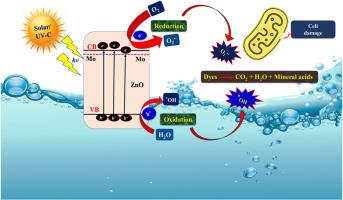Molybdenum-doped ZnO nanomaterials: A dual-function powerhouse for enhanced photocatalysis and antibacterial performance
IF 4.2
3区 材料科学
Q2 MATERIALS SCIENCE, MULTIDISCIPLINARY
引用次数: 0
Abstract
Dyes widely used across industries pose serious environmental and health risks due to toxic metals, aromatic amines, and formaldehyde derivatives. This study investigates a sustainable alternative by creating molybdenum (Mo)-doped zinc oxide (ZnO) nanoparticles with improved photocatalytic and antibacterial capabilities. Characterisation of structure, morphology, and optical properties was conducted using techniques such as X-ray diffraction (XRD), Fourier transform infrared (FT-IR) spectroscopy, Raman spectroscopy, photoluminescence (PL), UV–visible diffuse reflectance spectroscopy (UV-DRS), X-ray photoelectron spectroscopy (XPS), field-emission scanning electron microscopy (FE-SEM), high-resolution transmission electron microscopy (HR-TEM), and energy dispersive X-ray spectroscopy (EDS), indicated that Mo was successfully incorporated into ZnO. The photocatalytic performance was compared to three azo (–N![]() N–) dyes: Methylene Blue (10 ppm), Acid Black 1 (20 ppm), and Reactive Red 120 (50 ppm) under sunshine and UV-C irradiation at neutral pH. The 26.9 mol% Mo–ZnO catalyst achieved nearly 100 % degradation across all colours and demonstrated outstanding stability over four reuse cycles. Trapping investigations indicated that holes (h+) and hydroxyl radicals (•OH) were the main reactive species. The GC-MS study confirmed that methylene blue was transformed into less toxic intermediates. Furthermore, the Mo–ZnO photocatalyst showed strong antibacterial action against Staphylococcus aureus, Escherichia coli, Bacillus subtilis, and Pseudomonas aeruginosa. These results emphasise that Mo-doped ZnO nanoparticles have dual activity and practical potential for environmental remediation, particularly in wastewater treatment and antibacterial applications.
N–) dyes: Methylene Blue (10 ppm), Acid Black 1 (20 ppm), and Reactive Red 120 (50 ppm) under sunshine and UV-C irradiation at neutral pH. The 26.9 mol% Mo–ZnO catalyst achieved nearly 100 % degradation across all colours and demonstrated outstanding stability over four reuse cycles. Trapping investigations indicated that holes (h+) and hydroxyl radicals (•OH) were the main reactive species. The GC-MS study confirmed that methylene blue was transformed into less toxic intermediates. Furthermore, the Mo–ZnO photocatalyst showed strong antibacterial action against Staphylococcus aureus, Escherichia coli, Bacillus subtilis, and Pseudomonas aeruginosa. These results emphasise that Mo-doped ZnO nanoparticles have dual activity and practical potential for environmental remediation, particularly in wastewater treatment and antibacterial applications.

钼掺杂ZnO纳米材料:增强光催化和抗菌性能的双功能动力装置
由于有毒金属、芳香胺和甲醛衍生物,工业中广泛使用的染料对环境和健康构成严重风险。本研究通过创建具有改进光催化和抗菌能力的钼(Mo)掺杂氧化锌(ZnO)纳米颗粒来研究一种可持续的替代方案。利用x射线衍射(XRD)、傅里叶变换红外(FT-IR)光谱、拉曼光谱、光致发光(PL)、紫外-可见漫反射光谱(UV-DRS)、x射线光电子能谱(XPS)、场发射扫描电镜(FE-SEM)、高分辨率透射电子显微镜(HR-TEM)和能量色散x射线能谱(EDS)等技术对其结构、形貌和光学性能进行了表征。表明Mo被成功地掺入ZnO中。在阳光和中性ph的UV-C照射下,比较了三种偶氮(- nn -)染料的光催化性能:亚甲基蓝(10 ppm)、酸性黑1 (20 ppm)和活性红120 (50 ppm)。26.9 mol%的Mo-ZnO催化剂在所有颜色下都实现了近100%的降解,并且在四个重复使用循环中表现出出色的稳定性。捕获研究表明,空穴(h+)和羟基自由基(•OH)是主要的活性物质。GC-MS研究证实亚甲基蓝转化为毒性较低的中间体。此外,Mo-ZnO光催化剂对金黄色葡萄球菌、大肠杆菌、枯草芽孢杆菌和铜绿假单胞菌均有较强的抗菌作用。这些结果强调了mo掺杂ZnO纳米颗粒在环境修复方面具有双重活性和实际潜力,特别是在废水处理和抗菌应用方面。
本文章由计算机程序翻译,如有差异,请以英文原文为准。
求助全文
约1分钟内获得全文
求助全文
来源期刊

Optical Materials
工程技术-材料科学:综合
CiteScore
6.60
自引率
12.80%
发文量
1265
审稿时长
38 days
期刊介绍:
Optical Materials has an open access mirror journal Optical Materials: X, sharing the same aims and scope, editorial team, submission system and rigorous peer review.
The purpose of Optical Materials is to provide a means of communication and technology transfer between researchers who are interested in materials for potential device applications. The journal publishes original papers and review articles on the design, synthesis, characterisation and applications of optical materials.
OPTICAL MATERIALS focuses on:
• Optical Properties of Material Systems;
• The Materials Aspects of Optical Phenomena;
• The Materials Aspects of Devices and Applications.
Authors can submit separate research elements describing their data to Data in Brief and methods to Methods X.
 求助内容:
求助内容: 应助结果提醒方式:
应助结果提醒方式:


